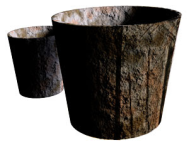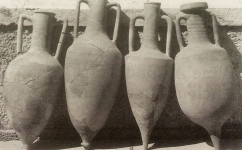- Reaction score
- 8,274
- Points
- 1,160
When this

becomes this

we might infer this

....
Orkneys.
3700 BC and the bowl at the top was all the fashion. The characteristic feature is the round bottom. It is known as Unstan Ware and was found in a particular type of cairn or mausoleum like that at the Knap o' Howar
By 3200 BC the fashion had changed to the flat bottom beaker. It is known as Grooved Ware and is associated with Skara Brae a Neolithic settlement. Skara was inhabited until 2500 BC, or about the same time as the Egyptians started building pyramids.
2500 BC is also about the time that the Bell Beaker became the fashion. The Bell Beaker is associated with the Bronze Age and regular trade between Britain and the Middle East and the Levant. Cornish tin likely supplied biblical wars.
But how do I get from bowls to saws?
....
A round bottomed bowl does not stand up right on its own. It has to be cradled in your hands or else supported in a bed of sand, or warm ashes, or snow or leaves. There are merits to all of those possiblities. But you can't put it down on a hard, flat surface. You can't put it down on a table.
Conversely, what is the advantage of a flat bottomed beaker unless you have a hard, flat surface on which to put it? Why you have a flat bottom unless you have a table on which to put it?
And how do you get a table smooth enough for that? Rock tables like those at Skara would still be pretty rough and your beaker would be tippy. The same is true of adze cut wood, especially when working with stone blades.
I believe it is possible to infer that people in the Orkneys, when they shifted from round bottom bowls to flat bottomed beakers, were already using saws and saws require metals. Bronze saws are known from Egypt and date back to 3000 to 4000 BC. They were known and they were available. They might be.
In which case the Bronze Age started to arrive in Britain before the Bell Beaker people with whom it is traditionally associated.
And the locals already had the benefit of domesticate large animals, specifically oxen, available to them to drag large stones across land or up rivers on rafts and barges.
With saws all sorts of things might be possible.
With oxen all sorts of things might be possible.
...

becomes this

we might infer this

....
Orkneys.
3700 BC and the bowl at the top was all the fashion. The characteristic feature is the round bottom. It is known as Unstan Ware and was found in a particular type of cairn or mausoleum like that at the Knap o' Howar
By 3200 BC the fashion had changed to the flat bottom beaker. It is known as Grooved Ware and is associated with Skara Brae a Neolithic settlement. Skara was inhabited until 2500 BC, or about the same time as the Egyptians started building pyramids.
2500 BC is also about the time that the Bell Beaker became the fashion. The Bell Beaker is associated with the Bronze Age and regular trade between Britain and the Middle East and the Levant. Cornish tin likely supplied biblical wars.
But how do I get from bowls to saws?
....
A round bottomed bowl does not stand up right on its own. It has to be cradled in your hands or else supported in a bed of sand, or warm ashes, or snow or leaves. There are merits to all of those possiblities. But you can't put it down on a hard, flat surface. You can't put it down on a table.
Conversely, what is the advantage of a flat bottomed beaker unless you have a hard, flat surface on which to put it? Why you have a flat bottom unless you have a table on which to put it?
And how do you get a table smooth enough for that? Rock tables like those at Skara would still be pretty rough and your beaker would be tippy. The same is true of adze cut wood, especially when working with stone blades.
I believe it is possible to infer that people in the Orkneys, when they shifted from round bottom bowls to flat bottomed beakers, were already using saws and saws require metals. Bronze saws are known from Egypt and date back to 3000 to 4000 BC. They were known and they were available. They might be.
In which case the Bronze Age started to arrive in Britain before the Bell Beaker people with whom it is traditionally associated.
And the locals already had the benefit of domesticate large animals, specifically oxen, available to them to drag large stones across land or up rivers on rafts and barges.
With saws all sorts of things might be possible.
With oxen all sorts of things might be possible.
...





